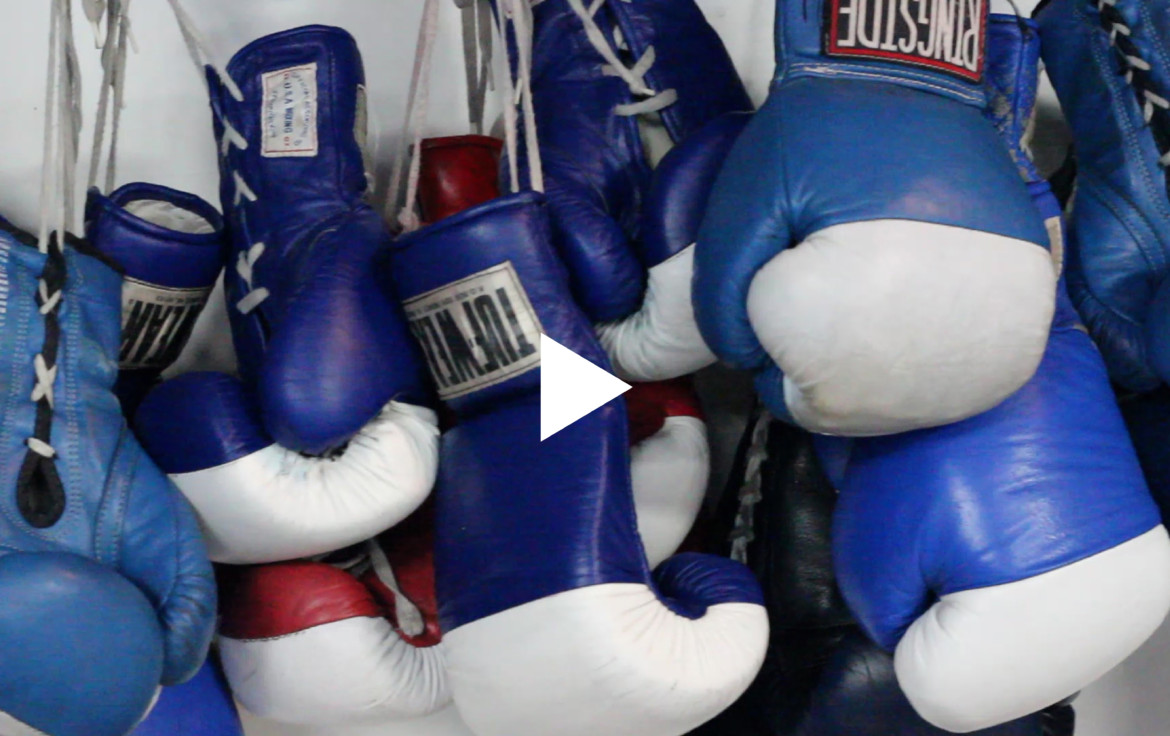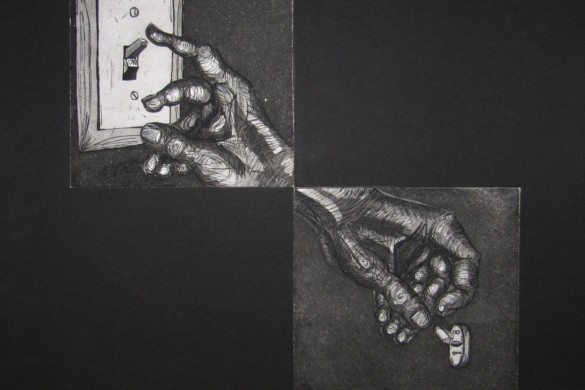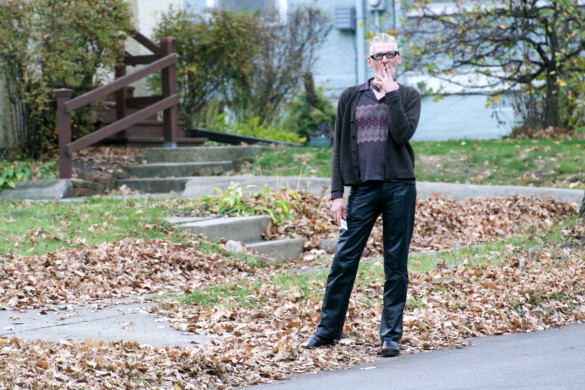Plagued by stigmas, the boxing industry is facing its toughest competitor yet —- the public
Words by Melissa Studach
Video by AJ Theide
A buzzer sounds as Helen Peralta steps into the ring. Bouncing. Her feet alternate swiftly. Weight shifts to the front. Jab. Jab. Coach Pepe Peña catches her blows. “Higher elbows. Lock your fists,” he demands. Jab. Cross. Her punch as hard as the skull and crossbones printed across her headband. Duck. Jab. She returns from Peña’s attack. Peralta’s braids hit her neck like a whip on a horse. She dances around the ring quickly, making it difficult to identify the tattoos that cover her jutting muscles. Her skills are impressive—especially considering the 28-year-old has only been boxing at the Southeast Des Moines Boxing Club for a month.
The walls of the gym are divided: Coca-Cola red paints the top, graffitied brick lines the bottom. A boxing ring fills half of the facility. Punching bags take up the remaining square footage. A stale musk consumes the entire place.
That same odor will permeate Peralta’s home via gym bag later tonight.
The Public
Boxing is in a different place than it was decades ago. Statista reports show that public interest is at the lowest it’s been in years. A majority of people even rated it as one of the professional sports least associated with positive moral values. The sport has lost its cachet in comparison to other athletic markets. Minimal broadcast coverage, highly publicized health concerns and a lack of support have plagued the sport for years. And aside from a few heavy hitters, boxing doesn’t compare to the payday of other sports, with the average fighter earning $20,000 to $200,000.
As a result, only about 30,000 male and female amateur athletes were registered with USA Boxing in 2016. Compare that to the 1.08 million high school students playing football or nearly 980,000 playing basketball.
Today’s influx of athletic options is one of the aspects threatening boxing, according to Christy Halbert, USA Boxing’s strategic sport consultant. What people don’t often see, she claims, are the great things the sport can do for individuals and communities.
“We’re battling a perception of boxing as a sport where people are intentionally trying to hurt each other,” Halbert says. “The more people get involved in the sport, the more they understand it’s about scoring points.”
In 2012, two percent of Statista respondents rated boxing as their favorite Olympic sport, while swimming got 21 percent. One month after the survey was completed, the USA’s Men’s Boxing Team failed to bring home a single medal—a first in U.S. Olympic history. Though one American Olympian earned a gold medal at the Rio Olympics, countries like Uzbekistan dominated the sport. And with foreigners reigning the boxing ring these days, U.S. fans can’t seem to maintain their enthusiasm. Many argue that the days of Cassius Clay and Sugar Ray Leonard are a thing of the past.
Coach Jerry Holman talks developing discipline.
The Parent
Stacy Cardines paces into the gym a little after training begins. She takes a seat on a bench against the wall. Her posture is stiff, appearing almost on edge. Holding her purse in her lap, she observes practice patiently.
A young boy races over and whispers something in her ear. She digs in her bag but can’t seem to find what he’s looking for. Shoulders dropped, he races back to practice. “That’s my son, Isaiah,” Cardines says. “He left his gloves at home.”
When 11-year-old Isaiah asked his mom if he could start boxing, she wasn’t as apprehensive as some parents may have been. “I knew some fighters that trained here and loved it,” she says. “So they told me to bring him down.” She had seen first-hand the self-discipline and character that could be developed inside the gym.
It’s only Isaiah’s second week at the Southeast Des Moines Boxing Club, but so far, he loves it. And his mom is enjoying it, too. “He’s making friends,” she says. “And it’s a good activity that has good role models.”
As she finishes her sentence, she glances up at the training. A high school-aged boy holds the punching bag as Isaiah attempts punches. He throws a feeble punch, barely touching the bag. The older boy readjusts Isaiah’s feet and shows him how to shift his weight before driving at the bag.
It’s not long before Isaiah is back at his mother’s side. This time, he forgot his mouthpiece. Owner Jerry Holman overhears the dilemma. He walks over and lifts the young boy’s sweatpants. “Well, did you at least remember socks?” he says with a smirk.
That he did.
Life’s just as simple as a boxing gym. It’s primal. It don’t ask nobody for nothin’.”
-Coach Jerry Holman
The Owner
Athletes at the Southeast Des Moines Boxing Club come to learn how to box, but they may take home a few new cuss words as well. Holman is to blame for both. “A boxing coach is a strange kind of person,” Holman says. “We ain’t politically correct about anything, and I’m probably one of the worst ones about it. My assistant coaches tell me, you can’t say this. Well, I just did and they just listened.”
Like many in the sport, Holman grew up in a “fighting family.” His father and grandfather both boxed. Today, he’s passed the tradition to his own kids and grandkids. But it’s obvious that anyone that enters Holman’s gym becomes family.
“Most of these kids aren’t Boy Scouts. They’ve got situations, and they’re looking for something that’s disciplined. Keeps them on a straight line, keeps them focused. And this does that,” Holman says. “These are all great kids. Some of them just ain’t never got a chance to shine.”
Post-fight photos and faded newspaper clippings cover the walls leading to Holman’s office. A tribute to those who once fought in the gym and inspiration for those in the ring today. “As you can see, I keep an organized office,” he says sarcastically as he settles at his desk. Trophies peek out from beneath paperwork and boxing gear. Cigarettes and dirty clothes fight for a majority of the odor. “I don’t worry about it too much,” he says. “It’s a boxing gym.”
It’s in his office, away from the buzzer and punches, that Holman discusses the toll public opinion has taken on boxing, citing safety concerns as one of the biggest stigmas facing the industry today.
While he admits to an occasional black eye or swollen nose, Holman argues that boxing is one of the safest sports, thanks to its three safety outlets: the ringside doctor, the referee and the coach. “You’re with these kids every night,” he says. “You’ll let them tough it out to the point that it’s done, but we’re not going to let them get hurt.”
According to a 2011 report by the Centers for Disease Control and Prevention, of all boxing and other combative sport injuries, only 5.9 percent of them were traumatic brain injuries (TBIs). Baseball, football and soccer reported some of the highest at 7.9, 7.2 and 7.7 percent, respectively.
“I’d rather have a 90-pound kid fight a 90-pound kid with three safety outlets there than have a 90-pound kid and a 150-pound kid with football helmets on get hit in the head,” Holman says. “And have you ever been hit in the head with a baseball?”
80 miles per hour. That’s the speed of the average fastball thrown by a high school baseball player. The Sports Concussion Institute reports the impact speed of a football tackle at 25 miles per hour. The impact speed of a professional boxer’s punch is just 20 miles per hour.
But it can be difficult to change public opinion. And these days, the industry is having a hard time keeping up with the fight. Holman has been in business in Des Moines since 1999. But as a non-profit facility, he admits it hasn’t been easy. Big business donations have dried up, leaving them, like many inner-city gyms, to rely on small donors and fundraisers to keep up.
“We’ve been broke, we’ve been up, we’ve been down, we’ve been beat, we’ve been back, but we’re still here,” he says. “That’s all that matters—we’re still here. I don’t know how many years I’ve got left, but I’ll be here ‘til somebody has to tote me up those steps.”
Tough times may knock the sport down, but Coach Holman says it won’t knock them out.
The Fighter
By day, Helen Peralta works as a culinary art instructor at Indian Hills Community College in Fairfield, Iowa. By night, she’s a 130-lbs lightweight boxer fighting toward a world title. And yes, her students are some of her biggest fans.
Peralta was 27 when she first got in the ring. After yelling her criticisms at the TV during the Ronda Rousey-Holly Holm Mixed Martial Arts fight, she decided to try it out herself. Although both are considered combat sports, MMA and boxing have very distinct rules –most notably boxing’s hands-only fight against MMA’s kicking and punching approach. After eleven months of practicing MMA, Peralta entered a boxing competition on a whim. And she won.
“I’m going to hold a world title,” Peralta says one month into her boxing training.
This is the first time Peralta has fought by choice. Growing up as a Dominican in the Bronx, fighting was a necessity. “I’m not white and I’m not black. I didn’t have a group, so it was hard making it home,” she says. “It was a fight almost every day. And I was pretty good at it.”
By the time she was 21, Peralta had had enough of “the big mall” that is New York City. She packed her bags and headed west. A friend told her to take a pitstop in Iowa, and she never left. Peralta loves the region, but she loves the athletic community she’s found there even more.
“When someone has a fight, everyone’s trying to help them get better—if you’re at the right gym,” she says. “We’re always talking about ways of getting better physically and mentally and how to overcome certain limitations. It’s an awesome community.”
The Southeast Des Moines Boxing Club is two hours from Peralta’s house in Fairfield. She drives the four-hour round trip every weekday for practice. “[The coaches] are not focused on what you’re doing right. They’re focused on what you’re doing wrong,” Peralta says. “Some people can’t handle that, but I prefer it. I don’t need anybody to sugarcoat things for me. That’s what my mom’s for.”
When Peralta is in the ring, there’s nothing sweet about it. Jab. Jab. A loud thump echoes from Coach Peña’s mitts after every punch. Each hit reminds her of her kill list, a curation of “the baddest females around” whom Peralta hopes to someday meet in the ring. “Elbows in. Hands up,” Peña directs. She ducks to dodge his blow. She knows that to be the best, she must beat the best. Onebyone, she plans to call them out.
“I don’t want an easy fight. Anyone on that list is there because I admire them,” Peralta says. “And because I want to punch them in the face.”











